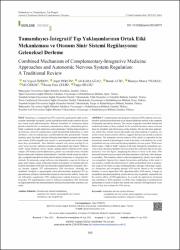| dc.contributor.author | Özden, Ali Veysel | |
| dc.contributor.author | Perçin, Alper | |
| dc.contributor.author | Karaağaç, Ali | |
| dc.contributor.author | Atik, Burak | |
| dc.contributor.author | Yılmaz, Hüsniye Merve | |
| dc.contributor.author | Özkoç, İdil | |
| dc.contributor.author | Çelik, Recep Enes | |
| dc.contributor.author | Bilgiç, Tuğçe | |
| dc.date.accessioned | 2023-12-30T09:04:09Z | |
| dc.date.available | 2023-12-30T09:04:09Z | |
| dc.date.issued | 2022 | en_US |
| dc.identifier.issn | 2630-6425 | |
| dc.identifier.uri | https://hdl.handle.net/11363/6835 | |
| dc.description.abstract | Tamamlayıcı ve integratif tıp (TİT) yöntemleri, günümüzde sağlık profesyonelleri tarafından idiyopatik, kronik hastalıkların tedavisinde yardımcı/ek yöntem olarak tercih edilebilmektedir. Bilimsel literatürde bu yöntemlere ilişkin
plasebo kontrollü, kör ve randomize çalışmaların az olması, yöntemlerin güvenilirliği ve etkinliği ile ilgili eleştirilere neden olmaktadır. Sıklıkla doğu felsefesi ve
tıp anlayışını içeren bu uygulamaların çeşitli hastalıklarda kullanılması ve etkili
olabilmesi, ortak bir mekanizmayı içerebileceklerini akla getirmektedir. Vücutta
meydana gelen fizyolojik olayların bilinçdışı kontrolünden sorumlu olan otonom
sinir sistemi (OSS) sempatik sinir sistemi ve parasempatik sinir sistemi olmak
üzere ikiye ayrılmaktadır. Stres faktörleri sempatik sinir sistemi aracılığı ile vücutta “savaş veya kaç” tepkisine yol açarken, parasempatik sinir sistemi “dinlen ve
sindir” olarak özetlenen, stresin vücutta yarattığı etkileri sönümleyen bir yapıya
sahiptir. OSS fonksiyonel bozukluklarının, primer veya sekonder olarak vücuttaki
birçok rahatsızlıkla bağlantısı bulunmaktadır. Genellikle kronik stresin de eşlik ettiği ve sempatik hiperaktivite lehine olan bu durum, homeostazı ve iyileşmeyi bozmaktadır. Bu çalışmada, yaygın kullanımı olan akupunktur, yoga, tai chi chuan, qi
gong, nefes terapisi, masaj, refleksoloji, hipnoz, kayropraksi ve osteopati gibi yöntemlerin etkinliğinin OSS aktivitesi üzerinden değerlendirilmesi amaçlandı. Mevcut literatür ışığında, TİT yaklaşımlarının OSS aktivitesini etkilediği öne
sürülebilir. Sempatik ve parasempatik sistem aktivitesindeki değişimler TİT uygulamalarının iyileştirici etkilerinden kısmen de olsa sorumlu olabilir. Sonuç olarak bahsedilen uygulamalar OSS regülasyonuna katkıda bulunuyor olabilir.
Gelecekte TİT uygulamalarını içeren ve irdeleyen çalışmaların OSS aktivitesini
de değerlendirmeleri etki mekanizmalarını anlama konusunda daha aydınlatıcı olacaktır. | en_US |
| dc.description.abstract | Complementary and integrative medicine (CIM) methods can be preferred by healthcare professionals as an adjunct/additional method in the treatment
of idiopathic and chronic diseases. The scarcity of placebo-controlled, blinded and
randomized studies of these methods in the scientific literature causes criticism
about the reliability and effectiveness of the methods. The fact that these applications, which often include eastern philosophy and understanding of medicine, are
used in various diseases and are effective, suggests that they may include a common
mechanism. The autonomic nervous system (ANS), which is responsible for the
unconscious control of physiological events in the body, is divided into two as the
sympathetic nervous system and the parasympathetic nervous system. While stress
factors cause a "fight or flight" response in the body through the sympathetic nervous system, the parasympathetic nervous system has a structure that can be summarized as "rest and digest", dampening the effects of stress on the body. ANS
functional disorders are associated with many disorders in the body, either primary
or secondary. This situation, which is often accompanied by chronic stress and favors sympathetic hyperactivity, impairs homeostasis and healing. In this study, it
was aimed to evaluate the effectiveness of widely used methods such as acupuncture, yoga, tai chi chuan, qi gong, breathing therapy, massage, reflexology, hypnosis, chiropractic and osteopathy through ANS activity. Based on the available
literature, it can be argued that CIM approaches affect ANS activity. Changes in
sympathetic and parasympathetic system activity may be partially responsible for
the curative effects of CIM applications. As a result, the applications mentioned
may contribute to ANS regulation. It will be more enlightening to understand the
mechanisms of action of studies that include and examine CIM applications in the
future, if they also evaluate the ANS activity. | en_US |
| dc.language.iso | tur | en_US |
| dc.publisher | Türkiye Klinikleri Yayınevi | en_US |
| dc.relation.isversionof | 10.5336/jtracom.2022-89773 | en_US |
| dc.rights | info:eu-repo/semantics/openAccess | en_US |
| dc.subject | Otonom sinir sistemi bozuklukları | en_US |
| dc.subject | Sempatik sinir sistemi | en_US |
| dc.subject | Parasempatik sinir sistemi | en_US |
| dc.subject | Tamamlayıcı tıp | en_US |
| dc.subject | İntegratif tıp | en_US |
| dc.subject | Autonomic nervous system diseases | en_US |
| dc.subject | Sympathetic nervous system | en_US |
| dc.subject | Parasympathetic nervous system | en_US |
| dc.subject | Complementary medicine | en_US |
| dc.subject | İntegrative medicine | en_US |
| dc.title | Tamamlayıcı-İntegratif Tıp Yaklaşımlarının Ortak Etki Mekanizması ve Otonom Sinir Sistemi Regülasyonu: Geleneksel Derleme | en_US |
| dc.title.alternative | Combined Mechanism of Complementary-Integrative Medicine Approaches and Autonomic Nervous System Regulation: A Traditional Review | en_US |
| dc.type | article | en_US |
| dc.relation.ispartof | Geleneksel ve Tamamlayıcı Tıp Dergisi | en_US |
| dc.department | Sağlık Hizmetleri Meslek Yüksekokulu | en_US |
| dc.authorid | https://orcid.org/0000-0003-2349-996X | en_US |
| dc.authorid | https://orcid.org/0000-0001-7974-6945 | en_US |
| dc.authorid | https://orcid.org/0000-0002-4327-7347 | en_US |
| dc.authorid | https://orcid.org/0000-0002-0315-8343 | en_US |
| dc.authorid | https://orcid.org/0000-0003-2999-1461 | en_US |
| dc.authorid | https://orcid.org/0000-0002-8490-751X | en_US |
| dc.authorid | https://orcid.org/0000-0002-1571-3981 | en_US |
| dc.authorid | https://orcid.org/0000-0002-3696-2071 | en_US |
| dc.identifier.volume | 5 | en_US |
| dc.identifier.issue | 2 | en_US |
| dc.identifier.startpage | 160 | en_US |
| dc.identifier.endpage | 169 | en_US |
| dc.relation.publicationcategory | Makale - Ulusal Hakemli Dergi - Kurum Öğretim Elemanı | en_US |
| dc.contributor.institutionauthor | Karaağaç, Ali | |
| dc.contributor.institutionauthor | Yılmaz, Hüsniye Merve | |

















